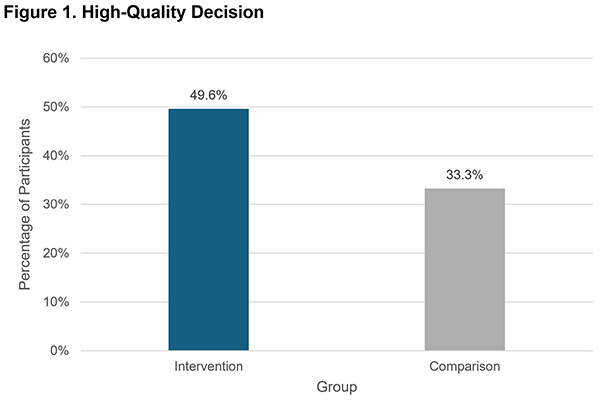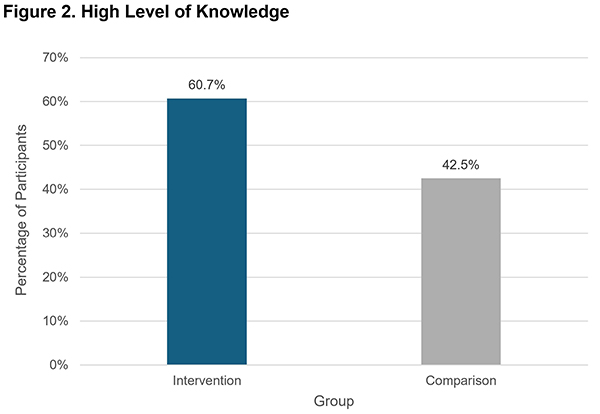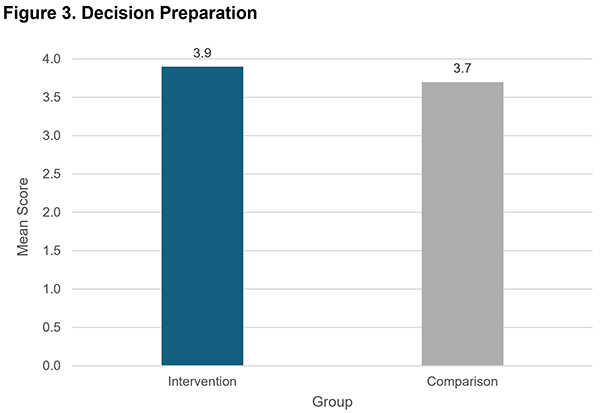The Implementation Guide is a resource for implementing this evidence-based program. It provides important information about the staffing and functions necessary for administering this program in the user's setting. Additionally, the steps needed to carry out the program, relevant program materials, and information for evaluating the program are included. The Implementation Guide can be viewed and downloaded on the Program Materials page.
Program Synopsis
Designed to improve treatment decision-making among women newly diagnosed with early-stage breast cancer, this intervention is an interactive web-based treatment decision tool. The study showed greater knowledge about breast cancer treatment options, higher achievement of a high-quality decision, and a higher level of decision preparation regarding breast cancer treatment.
Program Highlights
Program Materials
Preview and order the materials from the developer
Implementation Guide
Download Implementation Guide
Program Scores
The Need
According to 2024 estimates, there are more than 300,000 new cases of breast cancer and over 40,000 breast cancer deaths per year. Various breast cancer treatment options are available, and patients and their health care team can work together to create a treatment plan. It is important for patients to have knowledge of their treatment options and to prepare to make a decision about treatment with their health care team. Interventions are needed to inform breast cancer patients of their treatment options and help them make an informed decision on treatment.
The Program
iCanDecide is an interactive website designed to improve decision-making about treatment among women newly diagnosed with early-stage breast cancer. The intervention is based on several theories, such as the health belief model, social learning theory, and behavioral model of health services utilization. The website offers information to increase the patient’s knowledge and guided questions to help the patient clarify her own priorities around treatment options, two components needed for a patient to make an informed treatment decision. The tool requires patients to complete the sections in a linear format, engaging with all the content and features. Patients can go through all the sections in one sitting or over time; the process takes about 45 minutes. The intervention is divided into three modules:
-- Learning About Medical Therapy: The eight sections of this module share information about medicine that is used to treat the whole body (e.g., chemotherapy, HER2-directed therapy, endocrine therapy).
-- Learning About Surgery: The 12 sections of this module provide information about various aspects of surgery (e.g., survival, recurrence, recovery) and types of surgery (e.g., bilateral mastectomy, breast reconstruction). These sections include patient testimonials as well as exercises (e.g., expressive writing, meditation) to help patients process their emotions about making a treatment decision. This module also includes a values clarification exercise, offering real-time feedback to patients regarding the factors most important to them in treatment decision-making across four key areas: radiation therapy, keeping the natural breast, need for additional surgeries, and cosmetic outcome.
-- Genetic Testing: The five sections of this module introduce basic facts about genetic testing for cancer risks and provide an assessment designed to help women decide whether to undergo genetic testing.
Time Required
-- Minimal time to provide patients with information about how to access the website and create an account
-- Approximately 45 minutes for the patient to complete the web-based tool
Intended Audience
The intervention is intended for women newly diagnosed with early-stage breast cancer.
Suitable Settings
The program is suitable for implementation in the home and in clinical settings.
Required Resources
Required resources to implement the program include the following:
-- iCanDecide website
For costs associated with this program, click on Contact the Program Developer on the Program Materials page.
About the Study
A randomized controlled trial was conducted with early-stage breast cancer patients from 22 surgical practices in Michigan, Georgia, Tennessee, and California. Participants were randomly assigned to one of two groups: the intervention group receiving iCanDecide (n=267) or the comparison group given access to a static version of the iCanDecide website (n=270). The static version of the website contained the same basic content as iCanDecide but did not include tailored information or interactive features.
Participants were eligible if they were women aged 21 to 84 newly diagnosed with stage I or II breast cancer, spoke English, had not received surgical treatment, and did not have a contraindication for either mastectomy or breast conservation therapy. Women who received neoadjuvant chemotherapy were also eligible if they were considering surgical options.
The average age of participants was 56.8 years old; 79% were White, 16% were Black, and 5% were “other.”
Patients received an introductory letter and website login information. They logged in, provided informed consent, and completed a survey, and then they were randomly assigned to one of the two groups. They received a mailed follow-up survey 4 weeks after enrollment.
The primary outcomes were making a high-quality decision, having a high level of knowledge, and decision preparation regarding breast cancer treatment. Making a high-quality decision required both accurate knowledge about the risks and benefits of treatment options (high level of knowledge) and concordance between the chosen treatment and patient values. Patient knowledge was assessed using an adapted version of an existing 12-item knowledge scale developed to assess knowledge about both locoregional and systemic treatment. Answering 80% of the questions correctly was considered a high level of knowledge. Concordance between the chosen treatment and patient values was measured by comparing the treatment received with the treatment preference predicted by patient responses to a validated set of five questions that assessed the importance of various treatment outcomes (e.g., keeping the natural breast, avoiding radiation) to the patient. If the treatment received aligned with the treatment preference predicted, the treatment was considered concordant; otherwise it was considered non-concordant. Decision preparation was measured using a validated scale that assessed the degree to which participants felt the website prepared them for making a treatment decision. This measure was scored from a scale of 1 through 5, with a higher score representing greater preparedness.
Key Findings

- At follow-up, a higher proportion of participants in the intervention group than the comparison group had made a high-quality decision (p=.0004).

- At follow-up, a higher proportion of participants in the intervention group than the comparison group had achieved a high level of knowledge (p<.001).

- At follow-up, participants in the intervention group reported greater decision preparation than did the participants in the comparison group (p=.027).


